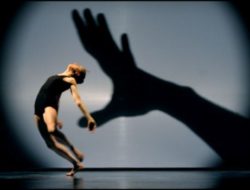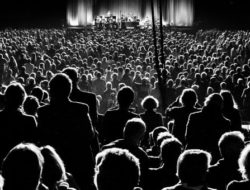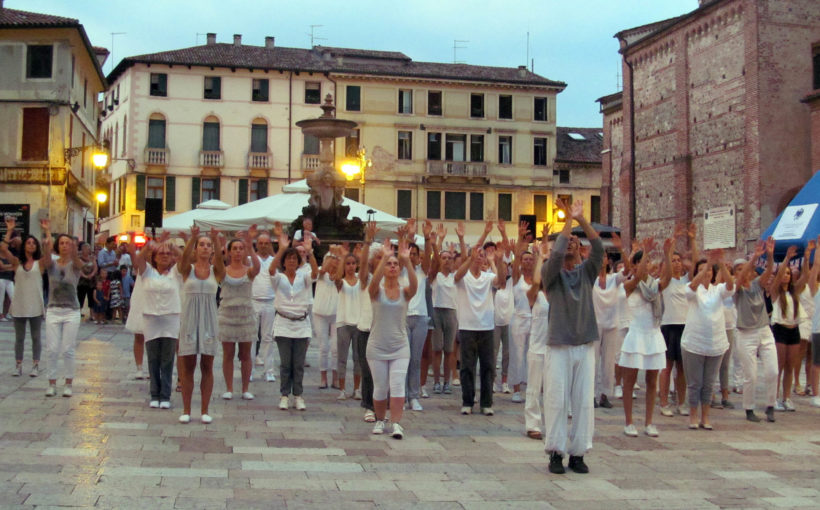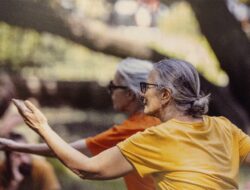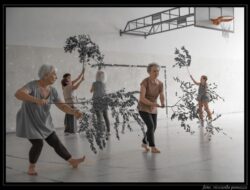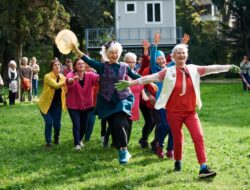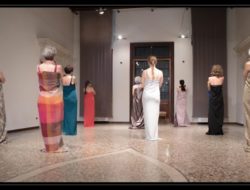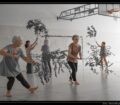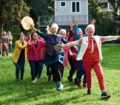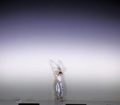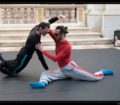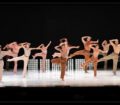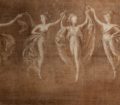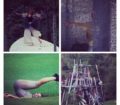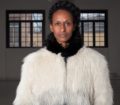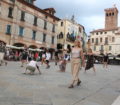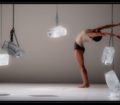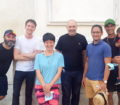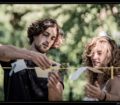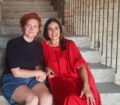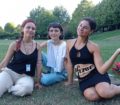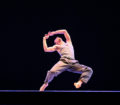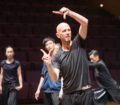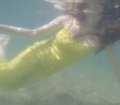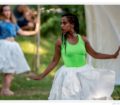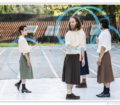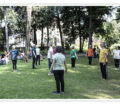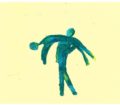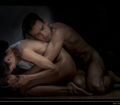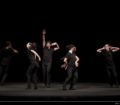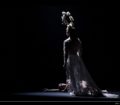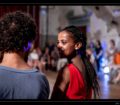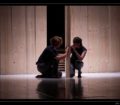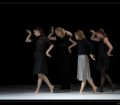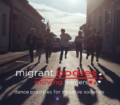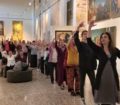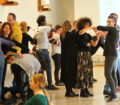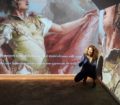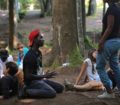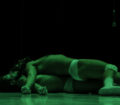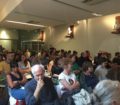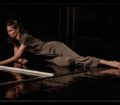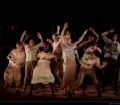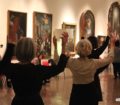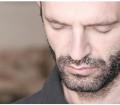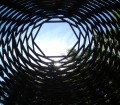Qualche mese fa ho scoperto i video di Matt Harding, meglio conosciuto come “Dancing Matt” e li ho trovati di una semplicità emozionante.
Harding si presenta dicendo: “I travel all around the world dancing badly with people”. Ed è effettivamente così.
Sono video nati inizialmente per gioco, e diventati poi virali, che riprendevano Matt mentre, in modo maldestro e sgangherato, ballava davanti ai monumenti e alle piazze delle città che visitava. Il suo ballo ha finito per contagiare centinaia di persone, e di lì a poco i video si sono trasformati in delle vere a proprie “Big Dance” che coinvolgono persone di ogni età, in ogni parte del mondo.
Nel 2008 la NASA ha pubblicato uno dei video di Matt nel suo sito intitolandolo “La gente felice che balla sul pianeta terra”.
Il fervore danzerino scatenato da Matt Harding mette simpaticamente in evidenza il valore sociale e politico, oltre a quello rituale, della danza, che inserendosi nel tessuto delle nostre vite collettive riesce a promuove non solo la bellezza e il divertimento, ma a dare vita a momenti in cui le comunità si possono riunire per celebrare la propria cultura e creatività.
All’inizio del 900, il padre della danza contemporanea Rudolf Laban sosteneva che ogni uomo è un danzatore e chiunque può essere coinvolto nell’esperienza della danza. Oggi quella che viene chiamata Danza di Comunità, nelle sue varie modulazioni, ha acquisito in alcune situazioni un valore “provvidenziale”, come nel caso dei danzatori del progetto “Dance Well” (movimento e ricerca per persone con il Parkinson), di cui parleremo anche nei prossimi giorni contrassegnando i contributi con l’hashtag #danzadicomunità #communitydance, e che vedremo in scena questo pomeriggio, a B.motion danza, nello Stabat Mater di Pablo Leyton.
E’ questo il caso in cui la danza diventa un'”alleanza di corpi” – come ha sottotitolato il suo lavoro il coreografo cileno – per un bene comune; mettere in gioco il proprio corpo è la prima modalità di percepirsi e di percepire l’altro, di farsi vedere e di vedere l’altro in modo diverso, extra-quotidiano, e questo a sua volta attiva fiducia nelle proprie e altrui possibilità, oltre ad avere, come nel caso del progetto “Dance Well”, un grande beneficio in termini di salute fisica.
Oramai sono molti i professionisti e centri che creano percorsi coreografici mettendo in dialogo interpreti non professionisti: da Luca Silvestrini al Centro Internazionale per la Danza di Rovereto, a Franca Zagatti a Bologna con i laboratori di Danza Educazione e Società, a Virgilio Sieni a Firenze con l’Accademia sull’Arte del gesto.
Come sono sempre di più i coreografi che coinvolgono nei propri lavori direttamente il pubblico presente in sala. Nella scorsa edizione di B.motion, per esempio, abbiamo visto anche l’audace Yasmeen Godder far interagire i danzatori del suo “Common Emotions” con alcuni “volontari” tra il pubblico, e un coinvolgimento ancor più grande è avvenuto nel suo commovente e delicato Stabat Mater.
Senza dimenticare poi il grande progetto corale “Rizoma” di Sharon Fridman, e “In Memoriam – after the end”, portato nei luoghi simbolo della Grande Guerra, con 100 danzatori e 300 coristi dai cori alpini, realizzato in seno a B.motion danza nel biennio 2015-2016. E non ultimo, “Minor place” di Giorgia Nardin, che ha debuttato ieri, ed è stato realizzato in coproduzione con il Festival per il progetto Pivot Dance.
Alla base di questa gioiosa spinta alla danza collettiva, spiega Alessandro Pontremoli, docente di Storia della Danza al DAMS di Torino, “c’è il coinvolgimento (di non professionisti) in una esperienza di relazione, l’individuazione di una gestualità che sia ‘naturale’, spontanea, conosciuta, non costruita, non un gesto imposto, che ha alle spalle una tecnica, ma già presente nel soggetto, il lavoro del coreografo è di tipo maieutico e costruttivo.”
“Tutte queste persone – continua Pontremoli – magari non danzeranno mai più, però questo diventa sicuramente un pubblico per la danza perché aver fatto esperienza diretta aiuta a capire dall’interno quel che si va a vedere.”
Appuntamento a questo pomeriggio per la prima nazionale di:
Pablo Leyton/Dance Well (Cile/Italia): “Stabat Mater – L’alleanza di corpi” – h 15 – Chiesetta dell’Angelo
Elena Giannotti (Italia): “Floating House (Hopeful on the way forward)” – h 19 – CSC Garage Nardini
Joseph Tonga (UK): “Daughter, Daughter – Before I met you” – h 21 – Teatro Remondini
Dario Tortorelli (Olanda): “D NO BODY 5#trascending” – h 22.30 – CSC Garage Nardini
______________
ENG
Happy people dancing on planet Earth
Just some months ago, I discovered Matt Haring’s videos, he is called also “Dancing Matt”, and I found their simplicity extremely exciting.
“I travel all around the world dancing badly with people”, Matt says about himself. And that is.
He started just for fun, but shortly after his video became viral. At first he danced alone in an awkward way in front of the monuments and in the squares of the cities he visited. But his dancing has hinfected thousands of people of every age, and shortly his videos became real `Big Dance` in every part of the world. In 2008 Nasa put one of Matt’s videos on its website calling it “Happy people dancing on planet Earth”.
Matt Harding has unleashed a dancing fevor that highliths the social and political value of dance, besides the value of being a ritual. Weaving into the fabric of our collective lives Dance can switch on not only beauty and fun, but has the power to build moments where the comunities can celebrate their culture and creativity.
At the beginning of year 900, the father of contemporay dance, Rudolf Laban said that every man is a dancer and everyone can be involved in the dance experience.
Today, Community Dance has obtained in each of its modulations a providential value, in particular in some situations like the project Dance Well (movements and research for people with Parkinson) – we will also talk about this in the next days by marking the contributions with #dancecommunity – on stage this afternoon at B.motion by Stabat Mater of Pablo Leyton.
In this case dance becomes an “alliance of bodies” – as the cilen choreographer subtitles his work – for a common goal. Gambling with our own body is the first way to get in touch with ourselves and the others, to show ourselves and see the others in a different, extra-daily way, and this, in turn, activates trust in one`s own possibilities and in the ones of the others.
There are many professionals and centers that create choreographic paths by interpreting non-professionals: from Luca Silvestrini at the International Dance Center of Rovereto, to Franca Zagatti in Bologna with the “Danza Educazione e Società ” workshops, to Virgilio Sieni in Florence with The Academy on the Art of Gesture.
And there are many choreograhers too that involve the audience in their performances.
In the last edition of B.motion, for example, we also saw Yasmeen Godder making the dancers of his her “Common Emotions” interact with some “volunteers” among the public, and an even greater involvement took place in her touching and delicate Stabat Mater.
Not to mention the great choral project “Rizoma” by Sharon Fridman, and “In Memoriam – after the end”, brought to the symbolic places of the Great War, with 100 dancers and 300 chants from the Alpine choruses, created in B.motion dance over two years 2015 and 2016.
We also had an example yesterday afternoon, with “Minor place”, Giorgia Nardin’s latest work, co-produced with the Festival for the project Pivot Dance.
At the basis of this joyous push towards collective dance, says Alessandro Pontremoli, professor of Dance History at DAMS in Turin, “there is the involvement (of non-professionals) in a relationship experience, the identification of a `natural` gesture, spontaneous, known, unstructured, not an imposed gesture, which is supportd by a technique, but already present within the subject, the work of the choreographer is of a maieutical and constructive nature.”
“All these people,” continues Pontremoli, “maybe will never dance anymore, but this is definitely an audience for the dance because having a direct experience helps to understand from inside what one is going to see.”
Rita Borga
Tags: #dancecommunity, #danzadicomunità, #stabat mater, Bmotion danza, Dance Well, Giorgia Nardin, operaestate, Pablo Leyton, Yasmeen Godder

